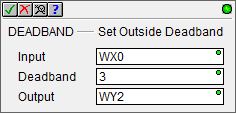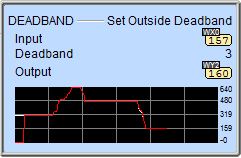Topic: DMD0136
DEADBAND - Set Outside Deadband
The Set Outside Deadband (DEADBAND) instruction generates a new Output value only when the Input value differs from the Output value by the Deadband Value. The Deadband value is applied equally above and below the Input Value.
A deadband (sometimes called a neutral zone) is an area of a signal range or band where no action occurs. The purpose of a deadband is to prevent oscillation or repeated activation-deactivation cycles.

Parameters:
Note: Use the F9 key (Element Browser) or Down-Arrow key (Auto-Complete) at any time to see a complete list of the memory locations that are valid in the current field of the instruction.
Input - designates the location to monitor. This can be any readable numeric location.
Deadband - designates the minimum amount of change allowed before a new output value is generated. This can be any constant value or readable numeric location.
Output - designates the location to store the new value. This can be any writable numeric location.
Status Display:
When the ladder status is ON (Debug-> All Status On), in addition to the standard status values being displayed, the Set Outside Deadband instruction also displays a small trend that shows the instruction's values graphically.
To disable the display of the trend go to the View-> Options menu, select the Ladder tab, then uncheck the Show Trend Status selection.

See Also:
DEADBAND - Set Outside Deadband
Rung Example:
